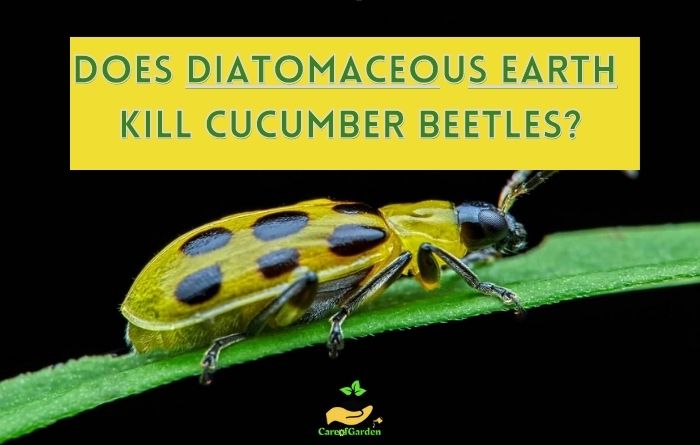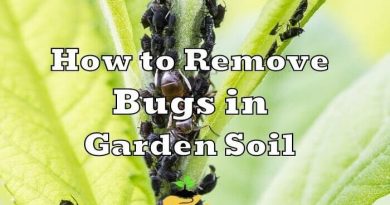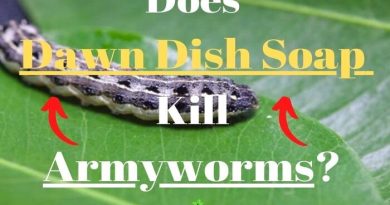Does Diatomaceous Earth Kill Cucumber Beetles? (Quick Answer)
As a gardener, I am always looking for ways to protect my plants from pests. One common pest that can wreak havoc on cucumber plants is the cucumber beetle. Look no further than diatomaceous earth! This natural insecticide has been touted as a solution for many garden pests, but does diatomaceous earth kill cucumber beetles?
Yes, Diatomaceous Earth (DE) can be effective in killing cucumber beetles. This natural substance works by physically damaging the outer shell of the cucumber beetles, resulting in dehydration and eventual death. When cucumber beetles come into contact with DE, its sharp particles penetrate their exoskeletons, causing them to lose moisture and perish.
In this post, we’ll dive into the science behind diatomaceous earth and its effectiveness against these pesky insects and share my own experiences using this substance in my garden.
Does Diatomaceous Earth Kill Cucumber Beetles?
After conducting some research, I stumbled upon an interesting fact: diatomaceous earth works wonders as a pesticide against those pesky cucumber beetles.
The sharp edges present in diatomaceous earth particles can penetrate the exoskeletons of insects, leading to their dehydration and eventual demise.
Scientific evidence suggests that diatomaceous earth (DE) is a reliable and safe option for controlling cucumber beetles. However, it is essential to note that it may take a few days for the diatomaceous earth to take effect, and it may not be as effective in wet conditions.
Unlike chemical pesticides, diatomaceous earth is a natural and non-toxic option. It is environmentally friendly and does not harm beneficial insects like bees and ladybugs.
In summary, diatomaceous earth is a useful tool for controlling cucumber beetles. Its effectiveness, safety, and eco-friendliness make it a popular choice among gardeners.
How Does Diatomaceous Earth Work in Cucumber Beetles?
As I researched about Diatomaceous Earth (DE) and its effectiveness in controlling cucumber beetles, I learned that DE works by contact. This means that when cucumber beetles come into contact with DE, it causes their outer layer to dry out and dehydrate, eventually leading to their death.
DE is composed of the fossilized remains of diatoms, which are minute, single-celled organisms characterized by their sturdy, silica-based shells. These shells possess sharp and abrasive qualities. As cucumber beetles encounter DE, these microscopic shells damage their exoskeletons, causing dehydration and ultimately resulting in death.
DE is an effective pest control option for cucumber beetles, particularly the striped and spotted cucumber beetle. It is important to note that DE works best when it is dry, so it is recommended to apply it on a dry day and avoid watering the plants for a few days after application.
In addition to its effectiveness, DE is also a natural and safe option for pest control. It does not contain any harmful chemicals, making it a great alternative to synthetic pesticides.
How long does diatomaceous earth take to kill Cucumber Beetles?
The time it takes for diatomaceous earth to effectively eliminate cucumber beetles can vary depending on various factors, making it difficult to provide a specific timeframe. Several elements come into play, including the severity of the infestation, the application method employed, and the beetles’ susceptibility to the substance.
Diatomaceous earth functions by physically harming the exoskeleton of insects, leading to their dehydration and eventual demise. When properly administered, the fine particles of diatomaceous earth can penetrate the outer layer of cucumber beetles, causing them to dehydrate and perish.
The actual timeframe for diatomaceous earth to kill cucumber beetles ranges from a few hours to potentially several weeks. It largely depends on the beetles’ direct contact with the diatomaceous earth. Applying the substance directly onto the beetles or strategically placing it on cucumber plant leaves and stems can enhance its efficacy.
Alternatives to Diatomaceous Earth for Killing Cucumber Beetles
If you’re searching for alternatives to diatomaceous earth for combatting cucumber beetles, you have several options to consider.
It’s important to note that the effectiveness of these alternatives may vary, so it’s advisable to experiment with different methods and determine what works best for your specific situation:
- Neem Oil: One effective alternative is neem oil. Derived from the neem tree, neem oil is a natural insecticide that can be used to control cucumber beetles. It works by disrupting their feeding and reproductive processes. Simply dilute the neem oil according to the instructions and spray it on the affected plants. The oil will suffocate the beetles, putting an end to their destructive behaviors.
- Insecticidal Soap: Now, another ace up your sleeve is insecticidal soaps. These soaps work their magic by suffocate those beetles, and you can either apply them directly to the critters or give your plants a nice spray. Take a gander at the product label for guidance on how to apply them and stay safe while doing so.
- Floating Row Covers: They’re like a protective shield that keeps cucumber plants out of the beetles’ reach. These covers are crafted from lightweight material that lets the sun, air, and water work their wonders while keeping those pests at bay. Just make sure you secure those covers tightly, leaving no room for the beetles to sneak their way in.
- Kaolin Clay: Kaolin clay is another natural solution that can deter cucumber beetles. When applied as a thin layer on plant surfaces, the clay creates a protective barrier that makes it difficult for the beetles to feed on the plants. Think of it as a shield for your cucumbers! Follow the application guidelines on the product label for best results.
How to Apply Diatomaceous Earth to Kill Cucumber Beetles
As I mentioned earlier, diatomaceous earth (DE) is a great natural solution to kill cucumber beetles. However, it’s important to follow some safety precautions before applying DE.
Safety Precautions
- Always wear gloves and a dust mask when handling DE, as it can irritate your skin and lungs.
- Avoid inhaling DE dust, as it can cause respiratory problems.
- Keep DE away from pets and children, as it can be harmful if ingested.
Now that we have covered the safety precautions, let’s discuss how to apply DE to kill cucumber beetles.
When to Apply
It’s best to apply DE in the early morning or late evening when the cucumber beetles are most active. You can also apply DE after a rain or watering, as it will stick better to the plants.
How to Apply
There are two ways to apply DE – as a spray or as a dust.
As a Spray
To make a DE spray, mix 4 tablespoons of DE per gallon of water. Stir the mixture well and pour it into a spray bottle. Spray the solution on the leaves and stems of the cucumber plants, making sure to cover both the top and bottom of the leaves.
As a Dust
To apply DE as a dust, simply sprinkle it on the leaves and stems of the cucumber plants. Be sure to cover both the top and bottom of the leaves. You can use a dust applicator or a shaker to apply the DE evenly.
How Often to Apply
You should apply DE every 7-10 days or after a rain or watering. This will ensure that the cucumber beetles are constantly exposed to the DE and will prevent them from laying eggs on the plants.
That’s it! By following these simple steps, you can effectively use diatomaceous earth to kill cucumber beetles and protect your cucumber plants.




